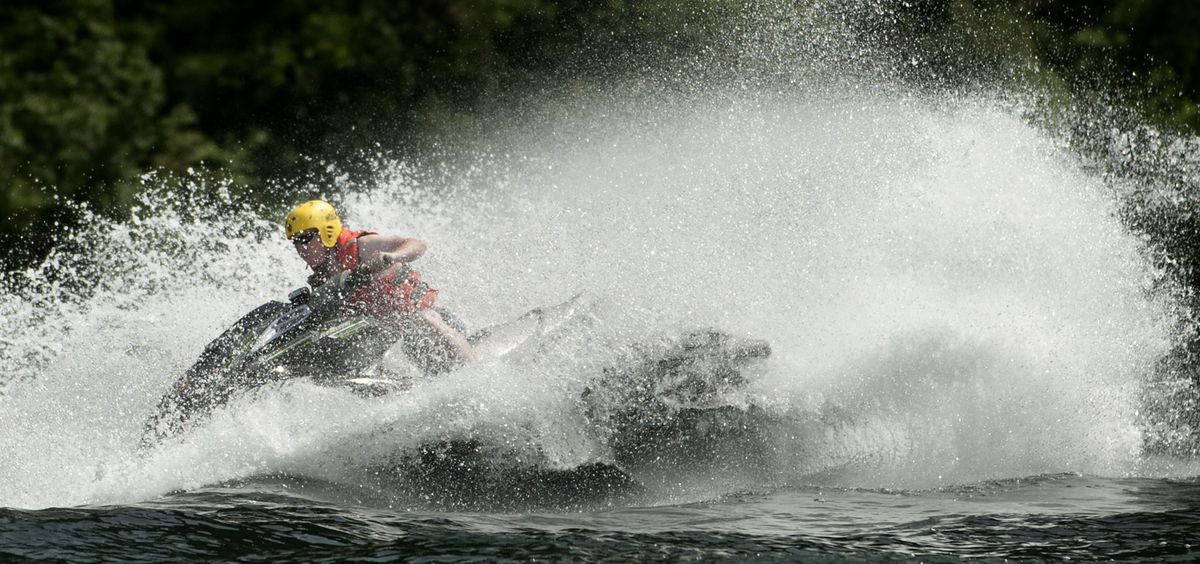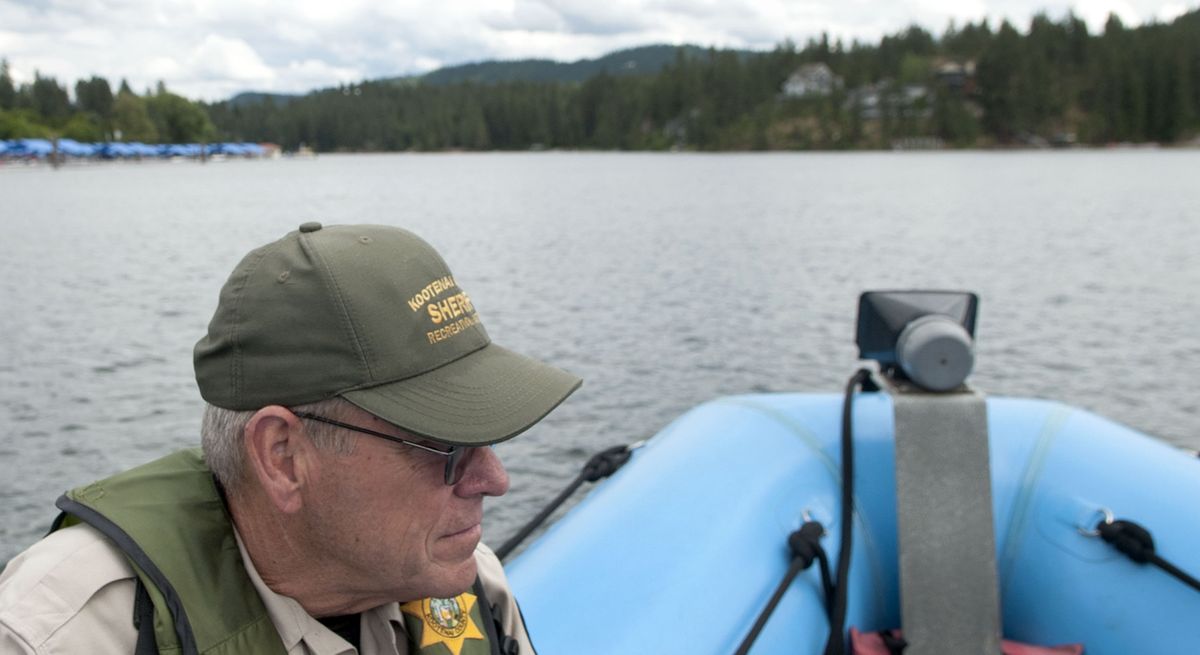Matching supersonic waves with safety
Kootenai County Marine Deputy Bryan Brumwell trains on the slalom course at Blue Creek Bay in Lake Coeur d'Alene. (KATHY PLONKA photos)
With the power of a motorcycle and the speed nearly to match, personal watercraft drivers are the drag racers of the water.
That speed and maneuverability can turn a hot summer afternoon into an epic day to remember. Or, that much power behind inexperienced hands can instantly transform the thrill into a tragedy.
Perhaps no group of outdoor enthusiasts is vilified more than those who operate personal watercraft. To the operators, the crafts – commonly referred to as Jet Skis – are freedom incarnate. They turn on a dime and accelerate with amazing power.
But they also tend to attract many who either don’t know boating rules or openly choose to ignore them. Those who choose to do the latter run the risk of encountering someone like Kootenai County Deputy Bob Bjelland.
“My passion is about safety on the water,” Bjelland said. “We’re here for those who don’t follow the rules of the road.”
With the boating season kicking off, the area waterways have begun to fill with kayakers, sail boat captains, motorboat operators and those with personal watercraft who all are supposed to reduce speed within 100 feet of any vessel, boat dock or buoy line.
Safety becomes even more precarious in a place like the Spokane River between Post Falls and Coeur d’Alene where all water users are jammed together on a relatively small body of water.
“It’s amazing. When people see us out patrolling, they slow down even if they don’t have to,” Bjelland said.
Washington requires boat and personal watercraft operators 59 or younger to obtain a boater card before they can legally operate on the water. But just to the east in Idaho, someone can buy a boat in Spokane and launch it that day on Lake Coeur d’Alene because the Gem State is not a mandatory education state.
“Anybody 14 or over can drive a vessel with unlimited horse power,” Bjelland said.
Bjelland recalled an accident in 2009 where a 14-year-old girl died after operating a personal watercraft for all of five minutes.
“She had been a passenger for half an hour and wanted to drive,” he said. “There were two personal watercraft. The one in front turned really hard. The girl drove directly into the wall of water. Upon impact, the passenger came forward and drove her chest into the console and she died.”
But as with anything, those who safely operate them can do amazing things.
Pete Roundy, 57, and his family sold the original Kawasaki Jet Skis starting in 1976. The family sold personal watercraft from then until last year when Roundy’s closed its Highway 2 location.
Roundy not only sold the machines, he raced them. He attended five U.S. Grand National Watercross Championships in Lake Havasu, Arizona.
“I just like riding them,” Roundy said. “I was always a dirt bike rider and snowmobiler. I snow skied and I raced Jet Skis.”
Newer models now have much more effective brakes, which actually is a function of the reverse mechanism. And, most use four-stroke engines, which are much quieter than the original models.
“They’re not really safer. They are bigger,” said Roundy, who owns a 1974 original Kawasaki Jet Ski.
The first models were known as stand-ups, where the operator stood as the Jet Ski moved. Roundy then began selling Sea-Doos in 1988 – a two-seat, sit-down model.
“After that the stand-ups kind of phased out. But they are coming back now,” he said.
Roundy once took a 40-horsepower motor out of a standup Jet Ski and put in a 115-horsepower snowmobile motor for the races at Lake Havasu.
“I had it up to 53 mph,” he said. “But they wouldn’t let me race it because it was too fast.”
The newer sit-down models can go even faster. Bjelland said they recently clocked a personal watercraft at 87 mph on Lake Coeur d’Alene.
“Last year we did about 4,900 vessel safety inspection. Doing that, we issued about 3,200 warnings and 202 citations,” he said. “We are probably a little softer than we should be at times. But, we have pretty good memories for boats and faces. If there is a pattern, warnings are off.”
Roundy said personal watercraft are as safe as the users. Like anyone who has spent any time on the water, he also has seen abuses.
“I used to get so mad,” Round said. “They’d be out buzzing boats or docks. I’d yell at them, ‘Don’t ruin it for everybody else.’ But, there are probably more boat accidents than Jet Ski accidents.”
Spokane County Deputy Jim Ebel said he and his fellow law enforcement tend to write most of their tickets on Long Lake to personal watercraft operators.
“They are great fun. But there is a lot of responsibility,” he said. “They need to follow all the same rules that larger vessels need to follow.”
Unlike a boat, personal watercraft must be under power to steer. That is why operators are required to wear a lanyard that shuts off the motor if they are thrown from the craft. If not, the Jet Ski becomes a driverless missile.
Bjelland said he has pictures of one that drove 50 feet up Independence Beach before it finally got bogged down in the sand. Luckily, it didn’t hit anyone on shore.
“You always know when an operator knows how to ride that thing,” Ebel said. “If they come over and turn it off, they run into your boat every single time.”
Just recently Ebel stopped a girl who appeared to be younger than 14. She was, and when she approached the deputy’s boat, she shut the personal watercraft motor off “and smacked the side of the jet boat. We wrote the grandpa the ticket for letting her operate,” he said.
Spokane County also uses Yamaha two-seaters to patrol the Spokane River below Spokane Falls.
“They are very fast and maneuverable. They are especially effective in searching shore lines in current,” he said.
But there is some water Ebel won’t use those personal watercraft.
“I’ll have four marine deputies on Newman Lake alone for the Fourth of July just for the boat parade,” he said. “People will be spraying each other in boats and Jet Skis racing in and around the boats. I won’t even let our Jet Skis go out because it’s so unsafe.”
When deputies make a stop, Bjelland said the operators always have a story.
“We listen to them. They are entertaining,” Bjelland said. “But our big push is boater education. We are convinced that boater education saves lives.”

